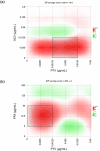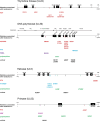Combined use of pritelivir with acyclovir or foscarnet suppresses evolution of HSV-1 drug resistance
- PMID: 39717706
- PMCID: PMC11665824
- DOI: 10.1093/ve/veae101
Combined use of pritelivir with acyclovir or foscarnet suppresses evolution of HSV-1 drug resistance
Abstract
The widespread use of antivirals in immunocompromised individuals has led to frequent occurrences of drug-resistant herpes simplex virus 1 (HSV-1) infections. Current antivirals target the viral DNA polymerase (DP), resulting in cross-resistance patterns that emphasize the need for novel treatment strategies. In this study, we assessed whether combining antivirals with different targets affects drug resistance emergence by passaging wild-type HSV-1 under increasing concentrations of acyclovir (ACV), foscarnet (phosphonoformic acid, PFA), or the helicase-primase inhibitor pritelivir (PTV), individually or in combination (ACV + PTV or PFA + PTV). The resistance selection procedure was initiated from two different drug concentrations for each condition. Deep sequencing and subsequent phenotyping showed the rapid acquisition of resistance mutations under monotherapy pressure, whereas combination therapy resulted in either no mutations or mutations conferring ACV and/or PFA resistance. Notably, mutations associated with PTV resistance were not detected after five passages under combination pressure. Strains resistant to both ACV and PTV were eventually obtained upon further passaging under ACV + PTV pressure initiated from lower drug concentrations. PFA + PTV dual treatment induced PFA resistance mutations in the DP, but PTV resistance mutations were not acquired, even after 15 passages. Our data suggest that combining the helicase-primase inhibitor PTV with a DP inhibitor may be an effective strategy to prevent drug resistance evolution in HSV-1.
Keywords: antiviral resistance; combination therapy; herpes simplex virus 1.
© The Author(s) 2024. Published by Oxford University Press.
Conflict of interest statement
None declared.
Figures



Similar articles
-
Combination of ganciclovir and trifluridine prevents drug-resistance emergence in HSV-1.Antimicrob Agents Chemother. 2024 May 2;68(5):e0011024. doi: 10.1128/aac.00110-24. Epub 2024 Apr 15. Antimicrob Agents Chemother. 2024. PMID: 38619252 Free PMC article.
-
Bone marrow transplantation in a child with Wiskott-Aldrich syndrome latently infected with acyclovir-resistant (ACV(r)) herpes simplex virus type 1: emergence of foscarnet-resistant virus originating from the ACV(r) virus.J Med Virol. 2002 Sep;68(1):99-104. doi: 10.1002/jmv.10175. J Med Virol. 2002. PMID: 12210436
-
Sequential switching of DNA polymerase and thymidine kinase-mediated HSV-1 drug resistance in an immunocompromised child.Antivir Ther. 2004 Feb;9(1):97-104. Antivir Ther. 2004. PMID: 15040541
-
Herpes simplex virus resistance to antiviral drugs.J Clin Virol. 2003 Jan;26(1):29-37. doi: 10.1016/s1386-6532(02)00263-9. J Clin Virol. 2003. PMID: 12589832 Review.
-
Management of acyclovir-resistant herpes simplex virus.Dermatol Clin. 2003 Apr;21(2):311-20. doi: 10.1016/s0733-8635(02)00093-1. Dermatol Clin. 2003. PMID: 12757254 Review.
Cited by
-
Cytomegalovirus infection and drug resistance emergence during letermovir salvage therapy in a pediatric SCID patient.NPJ Antimicrob Resist. 2025 May 28;3(1):43. doi: 10.1038/s44259-025-00118-y. NPJ Antimicrob Resist. 2025. PMID: 40437263 Free PMC article.
References
-
- Anton-Vazquez V, Mehra V, Mbisa JL. et al. Challenges of aciclovir-resistant HSV infection in allogeneic bone marrow transplant recipients. J Clin Virol 2020;128:104421. - PubMed
LinkOut - more resources
Full Text Sources

